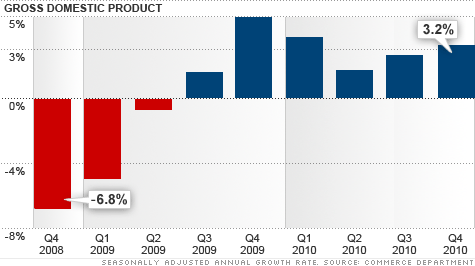Scammer
Banned

-- American consumers gave the economy a boost in the fourth quarter of 2010, as they loosened their purse strings.
Gross domestic product, the broadest measure of the nation's economic activity, grew at an annual rate of 3.2% in the last three months of the year, a significant increase from a 2.6% rise in the previous quarter, the government said Friday.
But that's still weaker than expectations. A group of 27 economists surveyed by CNNMoney had predicted GDP growth of 3.5%.
"The U.S. economy is finally, after three years, producing as much as it did before the Great Recession hit. But this is by no means 'mission accomplished,'" Economic Policy Institute economist Josh Bivens said in a research note.
"The 3.2% growth registered in the last quarter of 2010 would, if sustained over the next year, provide almost no downward push to the unemployment rate," he said.
The faster pace came mainly on the backs of American consumers, who headed back to the shopping malls during the holiday season. Personal consumption, a measure of consumer spending, jumped by 4.4% in the fourth quarter -- the strongest increase in that reading in at least four years.
"Consumer spending had an outstanding quarter," said Scott Brown, chief economist with Raymond James. "While some of that is due to a drop in the savings rate -- which isn't really sustainable -- it could also be a sign that consumers are less worried about losing their jobs."
Spending on so-called durable goods like cars and furniture rose a whopping 21.6%. Spending on nondurable goods like food and clothing was up 5%.
While the U.S. is struggling with a massive trade deficit, it improved slightly in the fourth quarter, lifting the overall GDP number. Exports increased at a rate of 8.5%, while imports decreased by 13.6% -- slightly narrowing the trade gap.
Not all cylinders of the economy were firing away though.
A slower pace of business inventories was the main drag on the overall number. Private businesses increased inventories by $7.2 billion in the fourth quarter, a stark contrast to $121.4 billion in the third quarter and $68.8 billion in the second.
Commercial and residential construction activity also decelerated significantly.
The government calculates GDP as a measure of goods and services produced in the United States. The number is backward looking and is often revised multiple times. This is the first reading for the fourth quarter.
For the year as a whole, real GDP was up 2.9%, a complete turnaround from the 2.6% decrease seen in 2009.
